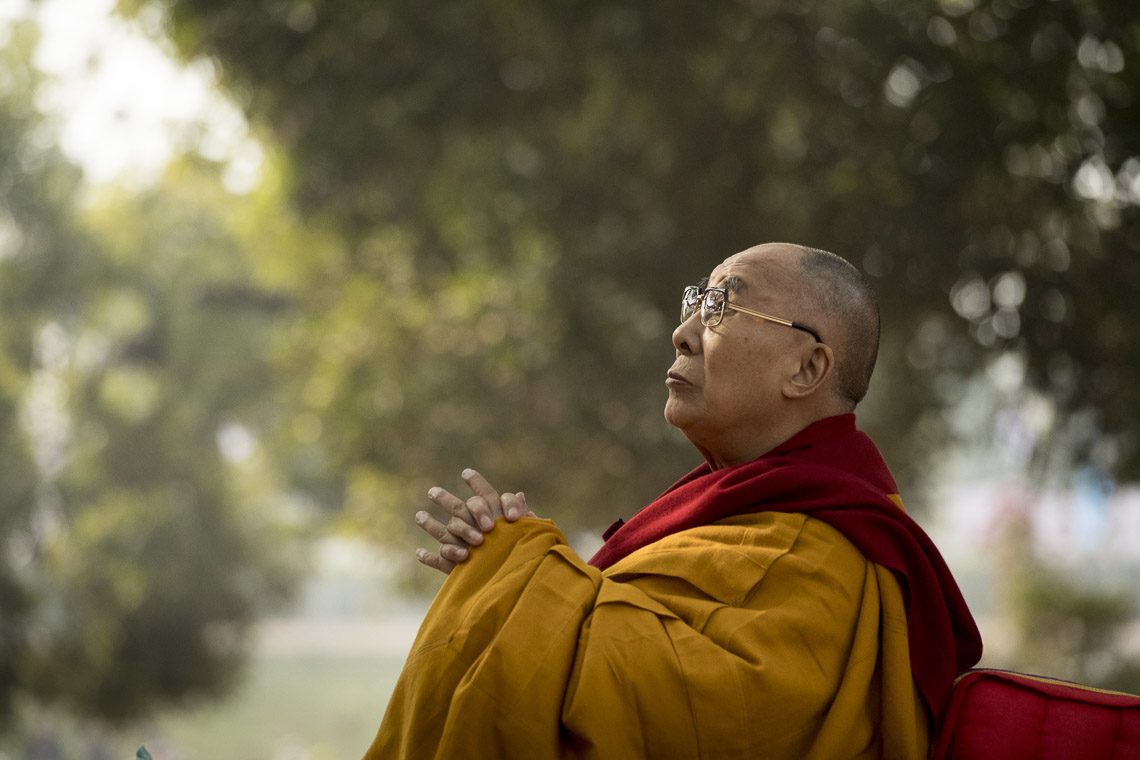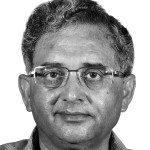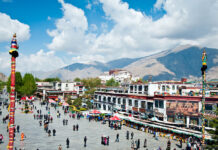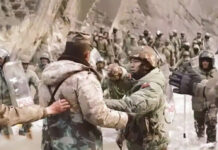
Dr. Sangay’s statement has only further confirmed fears among many observers that an influential section among the Tibetan exile leadership is desperate about cobbling up a deal with China on whatever terms. The very first negotiation point in this deal, as already declared by Dr. Sangay, is bound to be the return of Dalai Lama. Leaving Dalai Lama to the mercy of such lobbies will be a national hara-kiri.
 Vijay Kranti is a senior journalist, Tibetologist and Chairman, Centre for Himalayan Asia Studies & Engagement (CHASE)
Vijay Kranti is a senior journalist, Tibetologist and Chairman, Centre for Himalayan Asia Studies & Engagement (CHASE)
A question which is currently confronting most of Tibet-China watchers and Tibet supporters is, “is Dalai Lama seriously planning to visit or return to Tibet or China?” Three years ago the same question had created ripples when the idea of him visiting China’s famous holy Buddhist shrine of Wutai Shan was discussed loudly both in Beijing as well as in Dharamsala. On Sunday (1st April) again, Dr. Lobsang Sangay, the elected ‘Sikyong’ (the ‘President’ of Central Tibetan Administration in Dharamsala) stunned Tibet and China observers by announcing that time had arrived to fulfill Dalai Lama’s dream of returning to Tibet to ‘reunite with Tibetans’ and to live in Potala, the traditional palace residence of Dalai Lamas in the Tibetan capital Lhasa.
Dr. Sangay was speaking in Dharamshala at the opening function of ‘Thank You India’, the year-long celebrations organized by CTA to commemorate the 60th year of Dalai Lama’s arrival in India and to express Tibetans’ gratitude toward the people and government of India. It was on 3rd April, 1959 when Dalai Lama, the exiled ruler and supreme Buddhist leader of Tibet, arrived in India at the end of a 17-day long daring and grueling escape on foot through snow and mountains to save himself from arrest or killing by the occupying Chinese army in Tibet.
Interestingly these celebrations had already become focus of world attention following New Delhi government’s instructions to its senior bureaucrats and leaders to keep off public events involving Dalai Lama’s personal presence. This sudden toughening of New Delhi’s stand forced the CTA to cancel the main mega event of Dalai Lama in capital’s spacious Thyagraja Stadium. But it is not first time that New Delhi rulers have taken a stand of this kind which appears to be aimed at pleasing Beijing in the wake of Prime Minister Narendra Modi’s upcoming visit to China. In October 2007 too, the erstwhile UPA government had issued an identical diktat to its senior leaders and bureaucrats when Dalai Lama was given a civic reception at New Delhi’s India Habitat Centre for being honoured by the US Parliament with America’s highest civic honour — the Congressional Gold Medal (equivalent to Bharat Ratna of India).
According to Dr. Sangay the first dream of Dalai Lama was about seeing blood which, according to Dr. Sangay, turned true when Tibetans faced widespread killings of Tibetan protesters during uprising against the Chinese occupation of Tibet in 1959 and also in later years. The International Commission of Jurists, an affiliate body of erstwhile UNO, claimed that Chinese army killed more than 80 thousand Tibetans to crush the uprising in 1959. As per Dharamsala claims this number of unnatural deaths of Tibetans in Chinese occupied Tibet has crossed 12 lakhs (1.2 million) over past seven decades.
The second dream refers to Dalai Lama meeting ‘people in white’ which, Sangay says, again turned out to be true when Dalai Lama fled Tibet and met Indian leaders like Prime Minister Jawahar Lal Nehru and President Dr. Rajendra Prasad who were known for wearing dazzling white Khadi.
EXPLOITING RELIGIOUS SENTIMENTS ?
Citing these two ‘dreams’ of Dalai Lama turning out to be true, Dr. Sangay enthusiastically claimed about a third dream of Dalai Lama which gives an extraordinary political dimension to this statement, especially for coming out of the mouth of the Tibetan leader whom the Dalai Lama has transferred all his political powers through a constitutional amendment. Quoting Dr. Sangay Jyoti Malhotra of the Indian Express reported , “The Dalai Lama’s third dream, Lobsang Sangay said, was of him returning to the Potala palace filled with light and ‘reunited with Tibetan people’… This third dream will also come true by karmic design. We must all make efforts for His Holiness’ dream to return to the Potala palace come true, Sangay added.”
Referring to dreams of an individual may not hold much meaning for outsider observers and analysts. But in a deeply religious society like Tibet where no rule is above the words of Dalai Lama, Dr. Lobsang Sangay’s attempt to present Dalai Lama’s return to Chinese ruled Tibet as the religious leader’s “last unfulfilled dream” and his call to Tibetan people for making this ‘dream’ of Dalai Lama a reality, deserves a closer scrutiny by the Tibetan society, supporters of the Tibetan cause and, above all, the Indian government who have stakes in future of Tibet and its relations with China. This statement becomes extremely meaningful in the light of the fact that it is first time in past six decades that a senior(most) official of Tibetan government in exile has publicly endorsed Beijing’s agenda which is seriously focused at bringing back Dalai Lama to Chinese ruled Tibet before he is dead and the search for his next (15th) reincarnation starts.
PUSHING CHINESE AGENDA
It is noteworthy that in two major contacts between Dharamsala and Beijing, first held during late 1970s and early 1980s and second between 2002-2010 period, Tibetan side branded these meetings as ‘Tibet-China talks’ and ‘dialogue’ but Chinese side made it known public more than once that the visits of Tibetan delegations were ‘private’ in nature and the only subject of discussion was how to pave way for return of Dalai Lama to the ‘great motherland’. If followed in letter or spirit, Dr. Sangay’s plans about Dalai Lama’s return to ‘China’s Tibet’ is simple implementation of Chinese agenda which would mean a permanent closure of the dispute between Tibet and its colonial masters in Beijing.
Knowledgeable sources in MEA as well as India’s intelligence agencies who are keenly watching Dharamsala-Beijing contacts, believe that this announcement of Dr. Sangay has further strained the relations between New Delhi and Dharamshala. These relations have been already undergoing stress caused by a series of developments related to Dharamshala’s secret hobnobbing with Chinese government in recent past. A couple of years ago MEA had a serious brush with CTA, including the private office of the Dalai Lama when it was discovered that a meeting between Dalai Lama and a Chinese leader, holding rank of a minister, was secretly organized in Dharamsala without taking into confidence the MEA or security agencies that are responsible for Dalai Lama’s personal security. Similarly, recent China visit of Prof. Samdhong Rinpoche, the former ‘Prime Minister’ of CTA also did not go down well with MEA.
BOTH SIDES RESPONSIBLE
But it will be too naïve and unkind to Dharamsala if all the blame for such developments is heaped exclusively on CTA or Dalai Lama. It is no secret that over past six decades of Dalai Lama’s presence in India, the MEA has been perpetually as a loss and confused in evolving or adopting a well defined policy on Tibet — not even about the status of Dalai Lama, his activities and the scope of cooperation between him and the Indian government.
India abstained from and refused to support the first two resolutions in 1959 and 1961 in the UNO which condemned China for serious abrogation of human rights in Tibet. Rather, India stopped the rest of world from raising the issue of Tibet in the UNO. But following India-China war of 1962 India voted in favour of the same resolution when it was pressed third time in 1965. Indian representative Rafiq Zakaria’s strong statement against Chinese conduct inside occupied Tibet came as a pleasant surprise to the anti-China lobbies across the world. In later years also there have been many occasions when New Delhi allowed, rather facilitated, Dalai Lama’s visits to Arunachal Pradesh despite strong threats and reactions from China.
INDIRA GANDHI’S INITIATIVE
In the aftermath of 1962 war the Indian government went to the extent of raising an exclusive ‘Special Frontier Force’ (SFF) in the Indian Army which worked directly under the Cabinet Secretariat and has been popularly known as ‘Establishment-22’. In the Bangladesh liberation war during 1970-71 period a sizeable contingent of Tibetan ‘22’ guerrilla soldiers was secretly assigned the job of liberating the Tripura-Chittagong sector. Interestingly, the field operations of this secret contingent were personally supervised by Prime Minister Indira Gandhi herself.
On the day when Prime Minister Narendra Modi took oath in Rashrapati Bhawan in the presence of all heads of state from South Asia except China, the presence of Tibetan Sikyong Dr. Sangay in the VVIP enclosure gave indication that a brand new and different Tibet policy was in the offing. But later developments, especially the latest instructions of the NDA government to ignore ‘Thank You India’ have only confused the observers, and Dalai Lama too.
This sudden announcement by Dr. Sangay calling for Dalai Lama’s return to Chinese controlled Tibet has surprised many observers and institutions who have been keenly watching the Tibet-China-India triangle over past few decades. The uncommon attention that these remarks of the Sekyong has received, has prompted some other seniors in Dharamsala to suggest that it is nothing more than an off the cuff retort to New Delhi’s latest humiliating decision. Responding to my pointed question about Dalai Lama’s personal position on this issue, two prominent Tibetans who sit on two extreme ends of the ongoing political debate among the community disagreed with Dr. Sangay’s agenda.
FAITH IN DALAI LAMA’S WISDOM
Tenzin Tsundue (43) is the most visible and vocal signature of Tibetan ‘Rangzen’ movement, which stands for complete independence for Tibet as opposed to Dalai Lama’s ‘Middle Path’ for ‘genuine autonomy’. He says, “HH (Dalai Lama) is still the boss, not Sikyong. Lobsang Sangay’s showing the face in the media, on stage, being the head of CTA is still nominal and has little meaning. HH calls the shots.” Emphasizing his faith Dalai Lama’s wisdom he says, “please don’t underestimate HH’s political wisdom.”
Prof. Samdhong Rinpoche (81) a senior monk statesman out rightly rejected the idea of any plans to send back Dalai Lama to China or Tibet. Both of them remind that during his countless world tours the Dalai Lama has been always presenting India in a very positive light in his public speeches and one to one discussions with heads of state. Both of them regret that India could have used the international goodwill of Dalai Lama in enhancing its own interests in the world politics. The Dalai Lama has recently nominated Prof. Rinpoche and Dr. Sangay as his personal envoys to take ahead Dharamsala-Beijing ‘dialogue’.
DELHI OR DHARAMSALA — NEITHER CAN AFFORD IT
Whatever be the reality behind the prevailing confusion but one thing is clear. Neither Dalai Lama nor India can afford his slipping into Chinese lap at this delicate moment of Tibetan history. A dramatic decision like this will leave Dalai Lama, Tibet and Tibetan people completely at the mercy of Chinese whose previous record on their promises to Tibet is only too well known. By returning either permanently or even as a ‘pilgrim guest’ of a country (China) whose atrocities made him flee to exile, Dalai Lama will lose his legal and moral qualification as a ‘refugee’.
DALAI LAMA’S LOSS
Tibetan people may be happy to see their ‘Yeshi Norbu’ (meaning Precious-Gem and a common name for Dalai Lama) with their own eyes in their current life time. But this privilege will come at the cost of losing the momentum and courage of standing up against the tyranny for their colonial masters once they see their leader patching up with China. More than 150 Tibetans have committed self immolation inside Tibet against Chinese rule in recent years. The international Tibet support movement which has taken roots across the world over past six decades will die instantly and it cannot be revived in future if China ever goes back on its promises to Dalai Lama. His visit or return will permanently seal the fate of Tibet as an integral part of China and Beijing will get the license of nominating the future Dalai Lamas too.
By segregating the political and religious titles of the institution of Dalai Lama and handing over all his political powers to the elected representatives of Tibetans, the Dalai Lama had already given an endless shelf life to the Tibetan struggle and the institution of Dalai Lama itself. Sadly, his return to China will kill this achievement in its infancy.
INDIA STANDS TO LOSE
For India also, too big things are at stake to sit idle and allow the influential lobbies of Dharamsala to hand over a living Dalai Lama on a platter to China. With the return of Dalai Lama to Tibet or China all chances, whatever remote, of rehabilitating Tibet as a buffer between India and a quarrelsome China would be lost forever. But worst fall out of this Dharamsala-Beijing marriage will be the sudden transformation of the Himalayan states of India from India’s ‘first defence post’ to the Chinese front post of aggression because the local Buddhist populations have deeper religious bonds and relations with the Tibetan Buddhist system and monasteries inside Tibet than with the Indian plains.
INDIAN HARAKIRI ?
Dr. Sangay’s statement has only further confirmed fears among many observers that an influential section among the Tibetan exile leadership is desperate about cobbling up a deal with China on whatever terms. The very first negotiation point in this deal, as already declared by Dr. Sangay, is bound to be the return of Dalai Lama. Leaving Dalai Lama to the mercy of such lobbies will be a national hara-kiri on the part of Indian government. Rather, it would be much wiser for New Delhi to become pro-active on this front. By taking reasonable interest in the Dharamsala-Beijing dialogue New Delhi will not only strengthen Dalai Lama’s hands, but it will also give India enough elbow room to ensure its own interests in any prospective deal remain safe.
For New Delhi to start with, one not-so difficult move can be to publicly acknowledge Dalai Lama’s personal and institutional contributions to the Indian cultural and philosophic though process and to bestow upon him the ‘Bharat Ratna.’ After all, if India can honour friendly foreigners like Khan Abdul Gaffar Khan, Nelson Mandela and Mother Teressa with this Bharat-Ratna, then Dalai Lama’s name sound equally, if not more befitting. On the diplomatic front too, such a step will not only enhance the shelf life of Tibetan issue and value of Dalai Lama for India, it will be a very Gandhian and befitting response to China’s aggressive postures against India.
Mr Vijay Kranti can be contacted at v.kranti@gmail.com
Disclaimer: The views and opinions expressed are those of the authors and do not necessarily reflect the position of the Tibetan Review.






China’s cruel and cunning policy on Tibet and Tibetans and India’s timidness in dealing with China makes me sick. H.H the Dalai knows what to do and what not to do, His Holiness proclaims himself as a student of India and how come HHDL hurt government of India? HHDL had been awarded with many international awards, most famously the Nobel Peace Prize and Congressional Gold Medal of U.S.A. Why India hesitates to award Bharat Ratna to the most deserved Personality in this world, who always shines the name of India world wide. India will create a great historic moment if they could confer His Holiness the Dala Lama with Bharat Ratna. Government of India need to take a bold and very strong stance on the issue of Tibet, all these speculations of worry on the return of HHDL to Tibet doesn’t make much sense. This is not the era of 17 point agreement or the era of Chini Hindi Bhai Bhai and moreover the President of Tibet Dr. L.Sengey is also a politician, graduated on law from Harvard and above all I have a full faith that HHDL will take the right decision by not hurting the sentiments of Tibetan people and at large the grateful government of India.